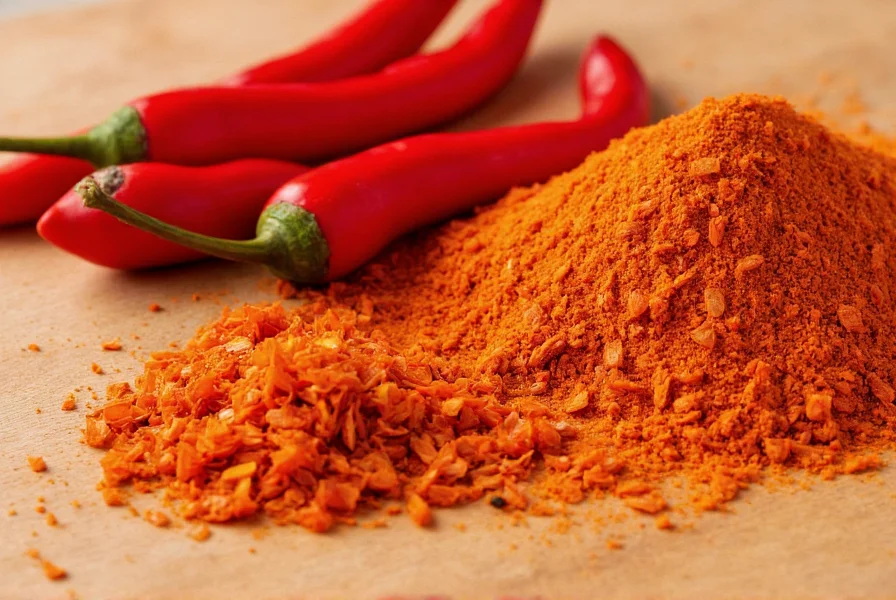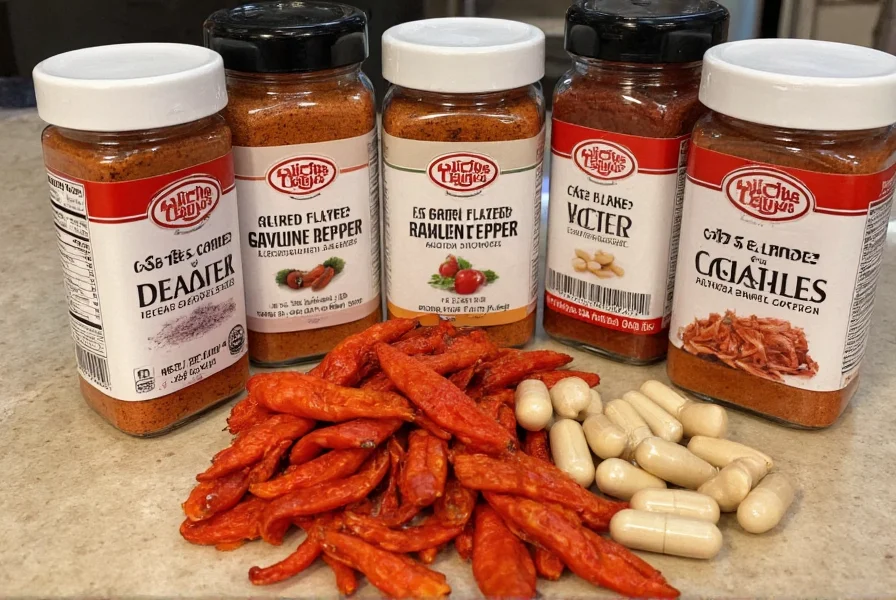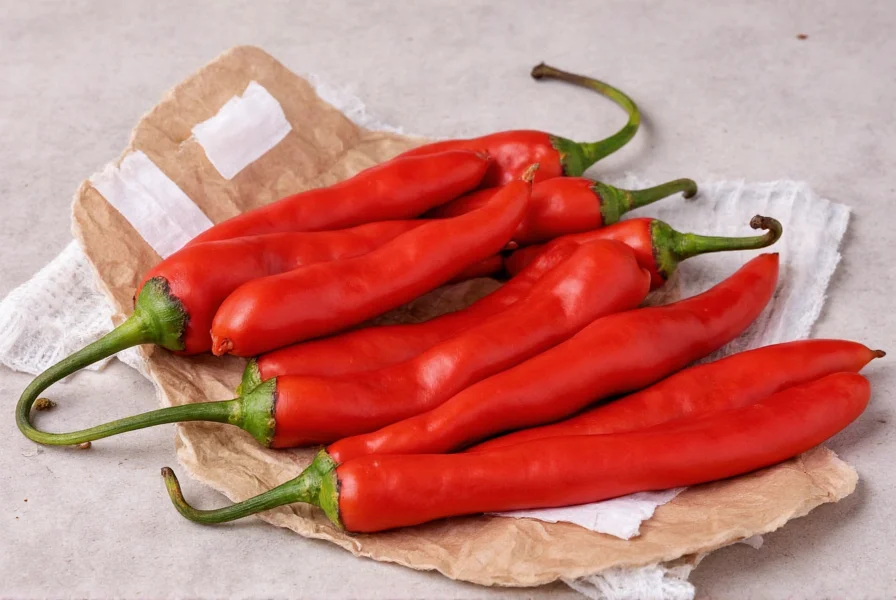Cayenne pepper, frequently misspelled as 'cyenne pepper,' is one of the most popular hot chili peppers worldwide. Understanding the correct terminology is essential for anyone exploring this versatile spice. The proper spelling—'cayenne'—derives from Cayenne, the capital of French Guiana, where this pepper variety gained international recognition. Botanically classified as Capsicum annuum, cayenne pepper measures between 30,000 and 50,000 Scoville Heat Units (SHU), placing it firmly in the 'hot' category of chili peppers but below extremes like ghost peppers or Carolina reapers.
What Exactly Is Cayenne Pepper?
Cayenne pepper refers to both the fresh long, slender chili peppers and the dried, ground spice made from them. These peppers typically measure 2-5 inches in length, ripening from green to vibrant red. The heat primarily comes from capsaicin, a bioactive compound concentrated in the pepper's placenta (the white ribs inside). When processing cayenne peppers into powder, manufacturers often include the seeds and membranes to maximize heat and nutritional content.

Historical Journey of Cayenne Pepper
Native to Central and South America, cayenne peppers have been cultivated for over 6,000 years. Christopher Columbus encountered them during his voyages, mistakenly believing he'd reached India, which is why they're called 'peppers.' Portuguese traders later introduced cayenne to Africa and Asia, where it became integral to many regional cuisines. By the 16th century, cayenne pepper had spread globally, valued both as a spice and for its preservative qualities.
Nutritional Profile and Key Compounds
Cayenne pepper's nutritional value extends far beyond its heat. Just one teaspoon (2 grams) contains:
| Nutrient | Amount per Teaspoon | Daily Value % |
|---|---|---|
| Calories | 6 | 0% |
| Vitamin A | 44% DV | Excellent source |
| Vitamin C | 8% DV | Good source |
| Vitamin B6 | 6% DV | Moderate source |
| Manganese | 5% DV | Moderate source |
| Capsaicin | 0.1-1.0% | Active compound |
The star component, capsaicin, interacts with pain receptors in the body, creating the burning sensation while triggering endorphin release. This compound has been extensively studied for its potential therapeutic effects, making cayenne pepper more than just a flavor enhancer.
Culinary Applications of Cayenne Pepper
Chefs and home cooks use cayenne pepper to add heat and depth to dishes across numerous cuisines. Unlike fresh peppers, ground cayenne distributes heat more evenly throughout a dish. Consider these culinary applications:
- Meat rubs: Combine with paprika, garlic powder, and black pepper for steak or chicken
- Sauces and marinades: Add 1/8 to 1/4 teaspoon per cup of liquid for controlled heat
- Baking: Surprisingly effective in chocolate desserts to enhance flavor complexity
- Preservation: Natural antimicrobial properties help extend food shelf life
When substituting cayenne pepper in recipes, remember that 1/2 teaspoon of cayenne equals approximately one fresh cayenne pepper. For milder heat, use paprika; for more intense heat, try cayenne pepper powder mixed with a pinch of powdered habanero.
Scientifically Supported Health Benefits
Research on cayenne pepper health benefits has grown substantially in recent years. The most compelling evidence supports these benefits:
Metabolic Enhancement
Multiple studies, including research published in the Journal of Biological Regulators and Homeostatic Agents, indicate that capsaicin can increase metabolic rate by up to 5% for several hours after consumption. This thermogenic effect makes cayenne pepper a popular ingredient in weight management supplements, though whole-food consumption provides additional nutritional benefits.
Pain Management
Capsaicin works by depleting substance P, a neurotransmitter that transmits pain signals. Topical creams containing 0.025-0.075% capsaicin have FDA approval for treating neuropathic pain conditions. Regular dietary consumption may also help reduce chronic pain sensitivity over time.
Cardiovascular Support
Research in the American Journal of Clinical Nutrition suggests that regular consumption of chili peppers correlates with a 13% lower risk of cardiovascular mortality. Cayenne pepper appears to improve blood vessel function and may help regulate blood pressure through its effects on nitric oxide production.
Practical Usage Guidelines
When incorporating cayenne pepper into your diet, follow these evidence-based recommendations:
- Start with small amounts (1/16 to 1/8 teaspoon) to assess tolerance
- Combine with healthy fats (like olive oil or avocado) to improve capsaicin absorption
- Use in morning meals to potentially enhance all-day metabolic effects
- Avoid excessive consumption before bedtime as it may disrupt sleep

Safety Considerations and Potential Side Effects
While generally safe for most people, cayenne pepper can cause issues when consumed excessively or by sensitive individuals. Potential side effects include:
- Temporary burning sensation in mouth and digestive tract
- Heartburn or acid reflux in susceptible individuals
- Skin irritation when handling fresh peppers (always wear gloves)
- Temporary increase in blood pressure immediately after consumption
People with gastrointestinal conditions like ulcers, Crohn's disease, or ulcerative colitis should consult healthcare providers before regular cayenne consumption. Those taking blood thinners should also exercise caution as cayenne may enhance anticoagulant effects.
Selecting and Storing Cayenne Pepper
For optimal flavor and potency, choose cayenne pepper products wisely:
- Fresh peppers should be firm, glossy, and uniformly colored
- Ground cayenne should have a vibrant red color (dull color indicates age)
- Store dried peppers in airtight containers away from light and heat
- Ground spices retain potency for 6-12 months; fresh peppers last 1-2 weeks refrigerated
When purchasing pre-ground cayenne, check for additives—pure cayenne pepper should contain only the ground pepper. Some commercial blends include anti-caking agents or other spices that alter flavor and heat profile.
Conclusion
Cayenne pepper, often misspelled as 'cyenne pepper,' offers far more than just heat. This versatile spice bridges culinary tradition and modern science, providing distinctive flavor while potentially supporting metabolic health, pain management, and cardiovascular function. When used appropriately and in moderation, cayenne pepper can be a valuable addition to a balanced diet. Understanding proper usage, storage, and potential interactions ensures you maximize benefits while minimizing any adverse effects. Whether you're a culinary enthusiast or health-conscious individual, incorporating this ancient spice thoughtfully can enhance both your meals and wellbeing.











 浙公网安备
33010002000092号
浙公网安备
33010002000092号 浙B2-20120091-4
浙B2-20120091-4